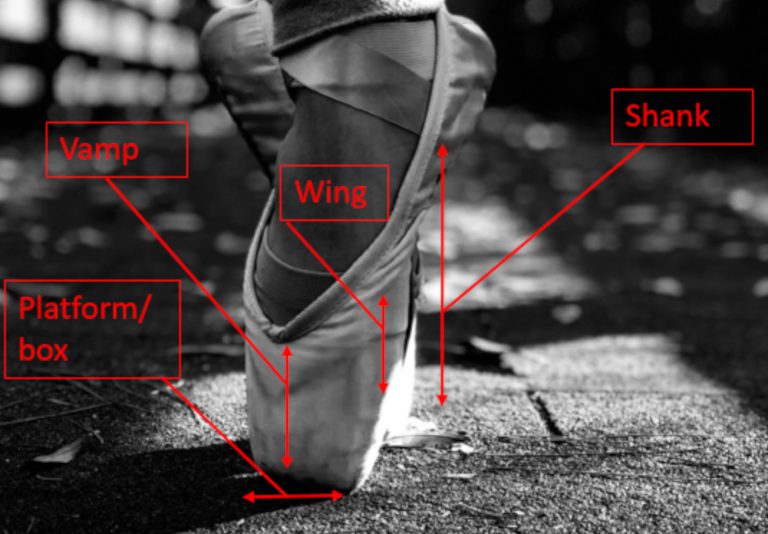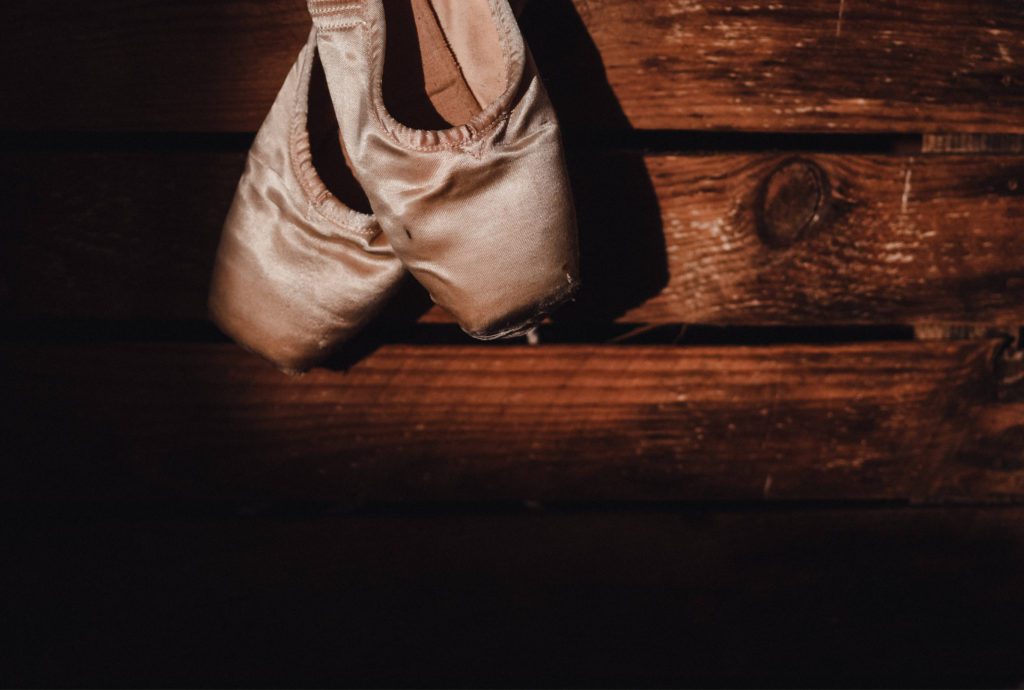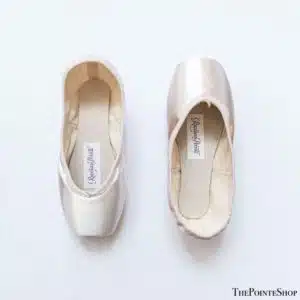Going en pointe is a technique where ballet dancers stand on the top of their toes in special, supportive shoes. Dancing on the tips of your toes adds elongated lines and an air of gracefulness to the dancer’s silhouette. An essential step in getting yourself ready for pointe class is buying pointe shoes that are comfortable and supportive, which might feel like a daunting task. With the variety of options and the technical aspects of securing the right fit, it can be hard to know where to start.
After comparing the aspects of various brands of pointe shoes, I have found that the Russian Pointe Rubin Pointe Shoe is the best overall shoe for its beautifully versatile design, high-quality construction, and competitive pricing.
Finding the perfect pair of pointe shoes is more than picking a promising brand. When shopping, you will need to consider the size, fit, and additional accessories needed to care for your shoes. Then, after purchasing your pair of pointe shoes, you will need to learn how to break them in and properly care for them to ensure product longevity and proper injury prevention.
Table of Contents
ToggleParts of the Pointe Shoe
You’ll notice some technical terms in the ranked list of best pointe shoes. These are aspects of the pointe shoe’s construction that make certain brands preferable for dancers.
Here is an explanation of the various parts of the pointe shoe for reference:

Vamp – The vamp of the pointe shoe is the length of the toe box and satin from the platform to the opening of the shoe
Wings – The wings of a pointe shoe are an extension of the vamp. It is the section of the shoe that dancers typically hold on to pull to shoe onto their feet.
Toe box – The toe box is the part of the shoe that holds the dancer’s toes. The box offers support that allows the dancer to balance on their toes while dancing.
Shank – The shank is the spine of the pointe shoe. It is the reinforced sole between the outer sole and insole. It supports the dancer’s entire foot while en pointe.
Platform – The platform is the end of the toe box. It is the part that the dancer dances on while standing on their toes.
Best Ballet Pointe Shoes
When searching for a pair of pointe shoes, it is recommended that you go into a store to get a professional fitting. A professional will assist you in finding a pair of shoes that is supportive and conducive to your body and dancing needs.
Due to the wide range of considerations when fitting pointe shoes, it is impossible to say which pair would be best for every individual dancer. However, there are some key characteristics – such as design, construction, pricing, variety, and availability – that help certain brands stand out.
After evaluating these characteristics in a variety of brands, I have put together this list of the best pointe shoes for professionals, beginners, budgeters, and dancers with wide feet.
Who should wear this shoe:
All dancers can wear these shoes from beginners to professionals.
Pros:
- High quality pre-arched construction to mimic the shape of foot en pointe
- Pleatless box for a polished finish
- Wide platform size
- Slightly tapered toe box
- Diverse variety of colors
- Competitive price
Cons:
- Palette colors are considered special order and may take up to 13 weeks
- No pleats to reduce noise
Who should wear this shoe:
From intermediate students to professional dancers.
Pros:
- Handmade with exquisite attention to detail
- The platform is shaped en pointe
- Strong, supportive, and light box
- Has a pro insole that is strong under the metatarsal and flexible under the heel
- Competitive price
- Constructed entirely with natural and biodegradable materials
- Deep cut vamp for a secure athletic fit
Cons:
- Less supportive design for newer pointe dancers

Who should wear this shoe:
Beginner to professional.
As an FYI, Bloch as a company has over 30 options of pointe shoes.
Pros:
- The platform’s wide oblong shape offers extra lateral support of the foot to help beginning pointe dancers stay en pointe
- Available in standard and strong shank making the shoe conducive to both class and performances
- Snug heel fit
- Noise reduction pleats, which are ideal for beginning dancers who may be more inclined to make noise
Cons:
- Added support might not be conducive to advanced dancer’s needs
- Some dancers may find the wide platform and firm shank uncomfortable
Who should wear this shoe:
The shoe can be worn by beginner to intermediate dancers.
Pros:
- The plush binding offers maximum stretch
- Heel design relieves pressure on the Achilles tendon
- Anti-slip microfiber lining to absorb excess sweat and friction
- Lightweight
- Bar-tacked (reinforced stitching) elastic drawstring to prevent pull outs
- Priced under $100 and commonly found on sale at Discount Dance
Cons:
- Doesn’t run true to size
- Not high quality enough to be used by professionals
Who should wear this shoe:
Russian pointe is a great brand for all dancers and has 6 variations in width size to accommodate dancers with even the widest feet.
Pros:
- Russian pointe’s roomiest pointe shoe
- Pliable shank
- Generous toe box volume and extra-wide toe platform. This also means dancers without wide feet can have more room to wear thicker toe pads for comfort
Cons:
- Expect a back order on any special-order shoe of 8-10 weeks
- Not available on Amazon
Pointe Shoe Sizing Guide
Sizing pointe shoes is a technical process specific to each dancer. However, it starts with a basic understanding of the different elements of a pointe shoe and how they should feel on your foot.
Factors to Consider for Size and Fit
1. Shank
The shank is the most important part of the pointe shoe as it keeps you supported on the tip of your toes.
Dancers can opt for a hard or soft shank depending on their preference.
A harder shank can feel more supportive, but a softer shank offers more comfortability and flexibility within the shoe. When the shank gets soft or breaks, you have to replace your pointe shoes because the shoe will no longer be supportive of movements en pointe.
2. Toe box
The width of the shoe is the main concern for the fit of the toe box. You want the toe box to be snug, secure, and supportive. Don’t necessarily assess for comfort. It won’t feel comfortable, but you don’t want there to be pain, pinching, or extra room.
3. Wings
The length of wings on the shoe should come to the big toe joint. Wings that are too low can cause bunions to form on your feet. Wings that are too high can prevent you from getting to demi-pointe correctly.
4. Heel
Your heel should come to the 7/8 mark on the heel bone. If your shoe covers the whole heel, you can injure your Achilles tendon.
5. Vamp length
The vamp of the pointe shoe is the length of the toe box and satin from the toe platform to the shoe’s opening. A vamp length that is too long will prevent you from going through demi-pointe. A vamp length that is too short and you risk going over the platform.
6. Shoe length
Pointe shoes should have extra room for you to lengthen your toes when you plié in second position. Your toes should just about touch the end of your shoe when you plié.
7. Alignment
Put one of your feet up en pointe and keep the other on the ground. Observe your foot. Your toes should not be moving as you lift onto the shoe’s box.
Do Ballet Brands Fit the Same?
The short answer is no, ballet brands do not fit the same.
In fact, sizing is so inconsistent that it even varies between styles of the same brand. Your foot’s shape, width, length of toes, and preferred toe pads are also examples of additional factors that cause inconsistencies in sizing pointe shoes.
Additionally, each brand has a different metric for how they measure important categories such as width. Some use the format XX-XXXX, others use N-W, others still use W1-W6. One has to wonder if this is done on purpose to retain customer loyalty!
Getting the right size pointe shoe is critical and, therefore, should be done by a professional. Due to the vast inconsistencies in pointe shoe sizing, this shouldn’t be a task you try to figure out through online sizing charts.
Our recommendation is, know your normal street shoe size in US, European, and UK conversions. It is also useful to have a rough idea of how wide your foot is (you can get an idea by going to your local shoe store). Take that sizing awareness with you as a starting point to your preferred ballet brand.
A Checklist for Shoppers
You’re ready to begin shopping for your pointe shoes. Congratulations! This is an exciting step in your ballet journey.
Below is a list of steps to follow before and during shopping.
Having this guide can help eliminate some of your anxieties surrounding this new and unknown process.
1. Book a professional pointe shoe fitting appointment or call ahead to make sure a staff member will be available to assist you at your local pointe shoe or dancewear retailer.
2. If you are already dancing en pointe, bring your old pair of pointe shoes. How these shoes were broken in can be a great indicator of how your alignment and what style of shoe would be most comfortable.
3. Bring ballet tights and the toe pads that you plan to wear with your pointe shoes for a more accurate fit. (If you have never danced en pointe before, the professional fitter can assist you in finding a pair of new toe pads to try on with your shoes.)
4. Make sure your feet are ready for a fitting. Don’t come right after a dance class as your feet will be swollen and sore.
5. Try on several pairs. Your fit and preference will change over your dancing career. Be open to a new shoe being a better fit.
6. Make sure and ask the professional assisting you about additional accessories needed. In addition to the pointe shoes, you will need to buy: Toe pads, ribbons, elastic, toe tape, stitch kit, and mesh pointe shoe bag.
How Many Pairs Do You Need?
If you are practicing en pointe every day, it is a good idea to have two pairs of pointe shoes. That way you can alternate which pair you wear while the other dries out. However, if you are only practicing in your pointe shoes once a week, one pair would be a good place to start.
It is not uncommon for professional dancers to go through 100 pairs of pointe shoes each season. At the advanced level, pointe shoes sometimes only last for one rehearsal or performance, depending on the complexity of the routine
What is the Best Brand of Pointe Shoe?
The best brand of pointe shoe is dependent on whom you are asking because every dancer’s foot, alignment, and dancing goals are different. Picking a pair of pointe shoes is a personal experience that cannot be translated to the next dancer in line.
However, popular brands such as Bloch, Capezio, Grishko, Freed, and Russian Pointe are well established and have options for dancers of all backgrounds.
How Much Do Pointe Shoes Cost?
Pointe shoes typically cost over USD 100 after adding $20 for accessories such as ribbons and elastic.
Pointe shoes last anywhere from a few hours to 12 hours of dancing. Sometimes a pair of shoes won’t last more than a single rehearsal due to the complex nature of advanced choreography.
Advanced to professional pointe dancers should be prepared to spend about $200/month on pointe shoes and accessories.
What to do Prior to Wearing Your New Pointe Shoes?
Prior to wearing your new pointe shoes, you will want to break them in. Breaking in your pointe shoes helps the shoes mold to your feet and eliminates unnecessary pain.
It is important to first consult with your professional dance instructor before attempting to break in your pointe shoes because you don’t want to risk breaking the shoe’s shank. If the shank gets broken or the box gets too crushed, the shoe will be deemed “dead” or unwearable.
Breaking in Your Pointe Shoes
Soften the box of the shoe:
Soften the box by squeezing the box with your palm or gently stepping on it.
Break in the shank:
Put your foot up en pointe and see where the heel of the shoe ends. This is where you should bend the shank. Move the heel back and forth in the place where the heel rests. Then, use your hands to gently bend the shoe back and forth.
Exercise whilst in the shoe:
After the shank is broken in, put on the shoe. Walk around on demi-pointe. Demi-pointe is where you put all your weight on the balls of your feet, so you are in a “half-pointe” position.
Then do some roll-throughs. Roll-throughs are where you roll from flat feet to demi-pointe and then onto to full pointe in one smooth motion. Also, bar work is a great way to break in your shoes.
Do You Need Pointe Shoes?
Only ballet dancers who are going en pointe need pointe shoes. First, consider your goals for advancement in ballet, and then consider the potential health risks of going en pointe.
If, after properly considering the risks and commitment it takes to go en pointe, you are still feeling motivated and curious about this next level, then you should discuss this with your dance instructor. If your instructor gives you the go-ahead, then you are ready to begin shopping for your first pair of pointe shoes.
Pointe Shoe Related Questions:
What is the best age range to start using pointe shoes?
Typically, ballet dancers start going en pointe between the ages of 11-13, but no younger. A dancer must have several years of good dance and strength training to make sure their feet, ankles, and legs are strong enough to handle the stress.
Who shouldn’t wear pointe shoes?
Children under the age of 11 should not go en pointe for risk of injury.
Dancers who do not take ballet classes consistently. (The typical recommendation is three ballet classes a week to prepare your body to go en pointe.)
Those with specific health risks that affect their ability to dance on the tips of their toes. Individuals with diabetes and osteoporosis would want to consult with their physician to understand the risks of going en pointe.
Are pointe shoes bad for your feet?
Dancing en pointe is an intense activity that can cause several injuries to your feet, muscles, and tendons.
Though these injuries are typically reserved for advanced dancers who are en pointe several days a week, even beginning dancers need to consider whether going en pointe is something they still wish to pursue.
Are there any pointe shoe brands to avoid?
You should avoid brands that aren’t right for your feet. Go and seek a professional fitting so that you can understand what aspects to look for in your pointe shoes. If you have wide feet, then buy a pair of shoes that can accommodate this.
The biggest factor in all of this is fit. If the fit is off, then you shouldn’t be wearing that shoe.
Another tip is, go for quality over price. Due to the somewhat risky nature of going en pointe, it is best to get a quality shoe that will take care of your feet instead of a cheap shoe that could cause you issues down the track.
What’s the difference between demi-pointe shoes and pointe shoes?
Demi pointe shoes are used in pre-pointe classes. They have a box shaped like a pointe shoe but no stiff shank in the sole. Demi pointe shoes are used to assist dancers in transitioning between ballet slippers and pointe shoes.
Demi pointe shoes should only be used according to your teacher’s instructions. Never attempt to stand or dance en pointe in a demi-pointe shoe. Without the shank for support, injury can happen.
How to store and clean pointe shoes?
The biggest thing to remember when storing your pointe shoes is to let them dry out to increase the longevity of your shoe’s life. After wearing your pointe shoes, remove the toe pads and place them in a mesh bag.
Do not put your shoes inside one another as this can prevent them from drying out and misshapen the box. Also, don’t put your shoes in a closed bag as it increases the risk of them remaining damp.
Never submerge your pointe shoes in water. If you have a stain on the shoe, use a toothbrush and a dab of detergent to remove it. If you are noticing an odor coming from your shoes, pour some baking soda inside to help absorb the sweat and reduce any smell.
How to make your pointe shoes last longer?
The best way to make your pointe shoes last longer is to keep them as cool and dry as possible. Heat means more moisture and moisture means a quick breakdown.
After using your shoes, place them in a mesh bag to air dry. If you live in a particularly humid climate or sweat more than the average dancer, consider placing your shoes in front of a fan after use.
For more information on this topic, including valuable tips and tricks, have a look at our article Length Of Time Dance Shoes Last: For every type of dance.





